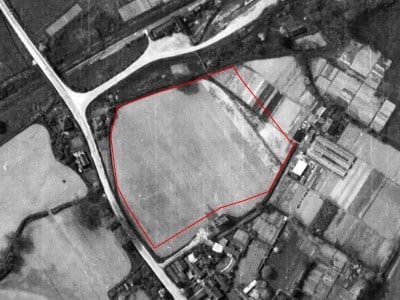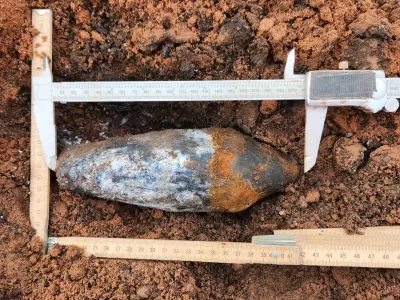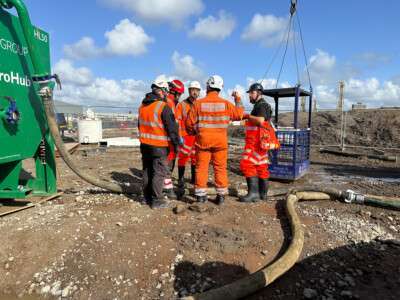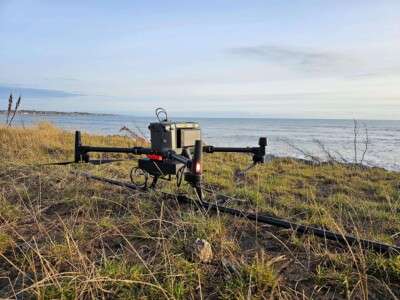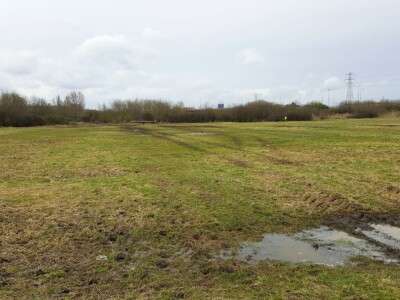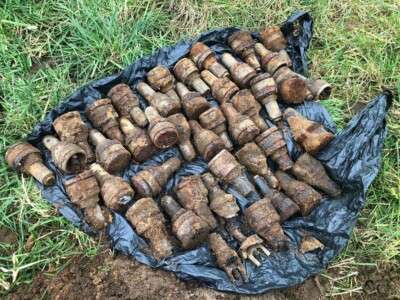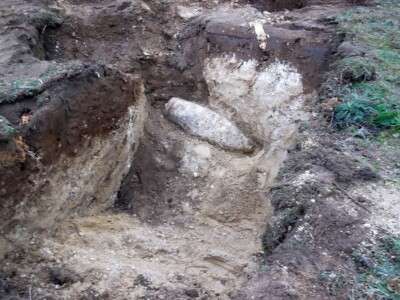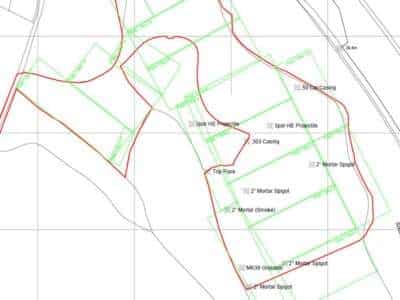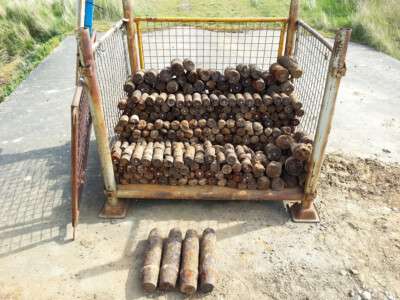Home » UXO Services »
What is a UXO Survey?
A UXO Survey is a means of proactive UXO Risk Mitigation undertaken to reduce the risk of encountering unexploded ordnance on a parcel of land, or marine environment, to as low as reasonably practicable (ALARP).
A UXO Risk Assessment should be undertaken first to determine whether a UXO Survey is required (based on the history of the site), and what type of survey is appropriate – based on factors such as the nature of the risk, the proposed scope of works and ground conditions.
The procedure for a UXO Survey involves scanning and probing the terrain to assess if there are unexploded items of ordnance embedded in the ground, this is to make sure any planned ground works can be completed safely and with the minimum amount of risk to those involved.
What UXO Surveys do we offer?
We provide a Non-intrusive UXO Survey (walkover, vehicle towed or Drone) and an Intrusive UXO Survey – and the type of UXO Survey we recommend will depend on the risk level of your project.
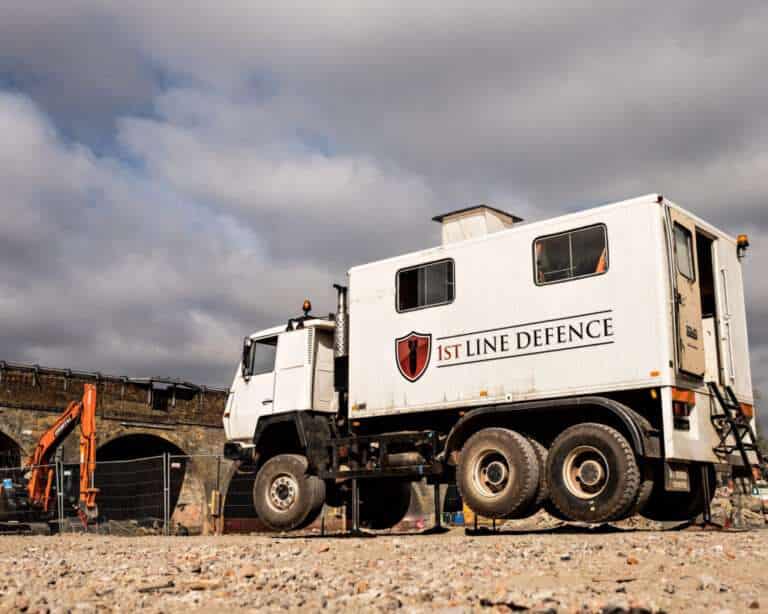
Looking for more information about UXO Surveys?
Non-intrusive UXO Survey
Drone / Aerial UXO Survey
Intrusive UXO Survey
Non-intrusive UXO Surveys
Ideal for Greenfield site projects (which is previously undeveloped land with little extraneous ferrous contamination).
By walking or towing a mobile detection system over the ground surface our equipment can map your entire project site location.
In good ground conditions, a Non-intrusive UXO Survey can detect a 50kg bomb up to 4m below the surface. It is also ideal for locating smaller and more shallow-buried items such as grenades, mortars and projectiles – both on land and over water.
Drone / Aerial UXO Surveys
Perfect for Greenfield land (which is previously undeveloped land with little extraneous ferrous contamination).
Using a Drone / Unmanned Aerial Vehicle (UAV) which has been installed with the latest magnetometer sensors, collision / obstacle detectors and laser terrain following technology, the drone is flown autonomously and can map a project site location area in a matter of hours.
This technology is particularly useful when trying to detect very small items of UXO or larger items which are buried deeper, it’s fast to deploy and can cover large areas.
Intrusive UXO Surveys
This survey is ideal for detecting deep buried bombs even on previously developed ‘brownfield’ land, and providing clearance of intrusive works ahead of piling or boreholes.
A magnetometer probe is pushed into the ground under hydraulic pressure, and we survey a column of soil to detect for deep buried unexploded bombs (UXBs).
Each survey position provides a column of clearance (diameter dependant on ground conditions) with more than one pile location covered by each survey (dependant on pile spacing) – reducing the overall number of surveys required.
“Just wanted say a huge thank you for sorting out the survey for us and fitting us in so quickly. The operatives on site have been absolutely brilliant over the last week and have kept us informed at every step of the way – even showing us how it all works. An absolute credit to you and your company. I wouldn’t hesitate for a second to use you again and indeed the lads would be top of my list. Please pass on our thanks once again to them.“
Site Manager, Urban Splash
Explore our Case Studies
Frequently Asked Questions
Browse the most commonly asked UXO Survey questions or contact us if you have a specific enquiry
UXO is an acronym for the term ‘Unexploded Ordnance’, which is used to refer to bombs, projectiles, small arms ammunition etc. which may have been fired, dropped, launched or projected and should have exploded but failed to do so. The size or shape of any item of UXO does not indicate its potential danger. Small items of UXO can kill and maim if handled incorrectly.
UXB is the acronym for ‘Unexploded Bomb’ – usually an air-delivered weapon which failed to function as designed. UXO refers to any type of ‘Unexploded Ordnance’ – for example, it would include items of small arms ammunition, landmines etc. as well as UXBs.
Items of UXO can contain unstable compounds which become more sensitive with age. UXO rarely becomes inert or loses effectiveness with time if it remains intact. However, buried UXO will not spontaneously explode if left alone. It would require some input of energy (heat, shock, vibration etc.) to initiate it.
UXO risk can vary considerably across the UK. In general, those areas which contained viable military / strategic targets were most at risk from bombing – major cities, industrial centres, docks, airfields, manufacturing sites etc. Some of the most densely bombed cities in the UK are listed below:
- UXO risk in Belfast
- UXO risk in Birmingham
- UXO risk in Brighton
- UXO risk in Bristol
- UXO risk in Canterbury
- UXO risk in Cardiff
- UXO risk in Chelmsford
- UXO risk in Clydebank
- UXO risk in Coventry
- UXO risk in Dover
- UXO risk in Exeter
- UXO risk in Great Yarmouth
- UXO risk in Hull
- UXO risk in Liverpool
- UXO risk in London
- UXO risk in Manchester
- UXO risk in Newcastle
- UXO risk in Plymouth
- UXO risk in Portsmouth
- UXO risk in Sheffield
- UXO risk in Southampton
- UXO risk in Swansea
- UXO risk in York
Current and former military land (airfields, ranges, training areas, munitions manufacturing and storage facilities etc.) can also often have a risk of UXO contamination.
Land Service Ammunition (LSA) and Small Arms Ammunition (SAA) are the most commonly encountered categories of UXO in the UK. LSA encompasses grenades, mortars, mines, rockets and projectiles. Of these, grenades, mortars and projectiles are the most commonplace, and are encountered with some frequency by members of the public and the construction industry – often on land historically used by the military. Unexploded German air-delivered bombs also pose a considerable risk in the UK, but are less common. Of the various types of German UXBs, the 50kg bomb was the most commonly dropped high explosive, and of the incendiary bombs – the small 1kg variant was the most widespread.
This is highly unlikely if the item of UXO has been buried deep in the ground, and even for shallow-buried items or items laying on the surface – a change in the conditions surrounding the item of UXO is needed to cause it to detonate.
The depth that an air-delivered bomb can penetrate into the ground depends largely on the density of the underlying geological strata. In generic ‘London Clay’ the maximum bomb penetration depth (BPD) for a 500kg bomb can be around 12m below ground level. However, the velocity of a UXB can be retarded and sometimes stopped by strata such as dense gravels or a high rock head. 1st Line Defence can provide site specific assessments of maximum BPD based on borehole logs or during on-site support.
Do not disturb it and get immediate assistance from the Police or from a commercial UXO risk mitigation company like ourselves.
Not necessarily. It is usually the case that the risk of UXO remaining will have been removed at the specific location of and down to the depth of post-war foundations and excavations. However, away from these areas, and at greater depths, the risk of UXO being present can remain. As an example, a 3m basement may have been excavated post-war. Down to this depth and in the area of the basement, the risk of UXO will have been removed. However, maximum bomb penetration depth can be up to 12m below ground level, so the risk of UXO remaining will not have been negated.
Possibly – however, each case and site is different. Finding a buried item like a WWII-era grenade or mortar may indicate that the area was utilised by the military historically, and that more might be present. If an unexploded air-delivered bomb was found in the area, it may demonstrate that during the war, ground conditions, frequency of access or levels of damage were such that evidence of a UXB entry hole was overlooked – and therefore that other such evidence could have gone unobserved.
There is no UK law that requires the construction industry to undertake a UXO Risk Assessment before starting ground works. However, the Health and Safety at Work Act 1974 and the Construction (Design and Management) Regulations 2015 require consideration of foreseeable risks – and UXO is a potential risk. The Construction Industry Research and Information Association (CIRIA) have produced a guidance report which is called – CIRIA C681: Unexploded ordnance (UXO) A guide for the construction industry. The report highlights best practices for the management of risks associated with UXO and covers what to expect from a UXO Specialist. Find out more about this guidance on our Resources page here.
It is important not to get complacent about the risk of UXO in construction sites across UK. Some cities, especially large cities like London, Liverpool and Birmingham, and coastal cities like Southampton were heavily targeted by the German Luftwaffe during WWII – and are prone to have more UXO risk due to more bombs being deployed.
Some of the most densely bombed cities in the UK are listed below:
- UXO risk in Belfast
- UXO risk in Birmingham
- UXO risk in Brighton
- UXO risk in Bristol
- UXO risk in Canterbury
- UXO risk in Cardiff
- UXO risk in Chelmsford
- UXO risk in Clydebank
- UXO risk in Coventry
- UXO risk in Dover
- UXO risk in Exeter
- UXO risk in Great Yarmouth
- UXO risk in Hull
- UXO risk in Liverpool
- UXO risk in London
- UXO risk in Manchester
- UXO risk in Newcastle
- UXO risk in Plymouth
- UXO risk in Portsmouth
- UXO risk in Sheffield
- UXO risk in Southampton
- UXO risk in Swansea
- UXO risk in York
Additionally, more and more construction projects are developed on ex-military land, which can also carry a significant risk of UXO contamination. Read more about roles and responsibilities of construction industry professionals when dealing with UXO here.
The majority of UXO encountered in the UK is not actually of German origin. During WWII, over 4,000,000 hectares of UK land were in use with British and Allied armed forces. The Construction Industry Research and Information Association (CIRIA) estimates that approximately 20% of the UK's land mass has seen some form of military activity at some stage. As of 2017, the MOD’s training estate covered around 364,000 hectares. For these reasons, the only way to be sure of identifying all UXO risks on your site is to carry out a UXO Risk Assessment.
Some construction companies still forget to consider or simply do not recognise the potential risk of UXO being present on their site. There are many recent examples of unexploded bombs (UXBs) being found on construction sites where no UXO Risk Assessment or mitigation work was undertaken – but where the accidental detonation of the item would have been catastrophic. The more responsible companies will assess / investigate UXO risk on their site as standard practice.
You may be putting people at risk. Although UXO risk in the UK is generally considered ‘low probability’, it is ‘high consequence’. Health and safety legislation requires you to consider foreseeable risks such as this. Even the unexpected discovery of an item of UXO can incur expensive downtime, delays and cost overruns. Being aware of the potential risk of UXO on your site is essential. You do not have to conduct a comprehensive UXO Survey for every site, but the risk of UXO should be considered and a Preliminary or Detailed UXO Risk Assessment undertaken.
There is no law which specifically requires a UXO Risk Assessment to be completed. However, every employer is obliged to make an assessment of the health and safety risks arising from carrying out their work. To check if there is a risk of UXO on your site, you should assess it first before proceeding with any intrusive ground works. Some local planning authorities will specify that a UXO Risk Assessment is carried out as a minimum precaution. A Preliminary UXO Risk Assessment can be undertaken by any construction professional, providing they are competent and have access to the relevant information. However, most companies choose to commission this from UXO Specialists such as 1st Line Defence.
1st Line Defence provide two types of UXO Risk Assessment – Preliminary and Detailed. A Preliminary Assessment will inform a client of whether more detailed research needs to be undertaken, or whether nothing obvious is going on and therefore ‘no further action’ is required. A Detailed UXO Risk Assessment will provide an overall risk level from UXO on site once comprehensive research has been undertaken, and will make full recommendations for any follow-up on-site UXO support / survey work based on the nature of the risk and the client’s scope of works.
Our Preliminary UXO Risk Assessments are desk based and can usually be completed within 1 or 2 working days. Preliminary UXO desk study reports offer a fast and cost-effective way to establish whether further research is required – or whether the risk can be negated at an early stage. Production time for our Detailed UXO Risk Assessments is around 5 to 7 working days (once research has started) and on average take between 5 and 10 or more days to complete – depending on the size and complexity of the site. If a quicker turnaround is required, mention this when ordering – even if we cannot produce the full report, we can usually make an initial assessment of risk and provide interim risk mitigation measures.
A Preliminary UXO Risk Assessment provides a quick overview of a general area to establish whether there is an increased probability of UXO being present, for example due to WWII bombing or previous military use. The Detailed UXO Risk Assessment involves considerably more research and will involve the interrogation of numerous datasets – which includes data that is not available in the public domain – to establish whether your specific project is at a higher risk of potentially encountering UXO. This assessment will determine the type of UXO (if any) that may be present on your site, the likelihood that you will encounter it and if necessary – what on-site risk mitigation measures we recommended to minimise the risk.
Rarely. Most of our research is desk-based using datasets we store in our offices or access at public record offices. However, we do visit sites if it can assist the process and better inform us of factors such as post-war development – especially for larger developments that may have different risk levels in different parts of the site.
Unfortunately not. They are often incomplete and should be used in conjunction with other records wherever possible. For example combining information from WWII-era aerial photography, bomb census mapping and written bomb incident records would give a more accurate indication of where a bomb fell than one of these sources alone. It is imperative that historical research for UXO Risk Assessments is thorough and that all available resources are utilised.
Yes – many unexploded bombs do not penetrate straight into the ground, but more commonly conform to a ‘J-Curve’ – ending their trajectory at a lateral offset from point of entry. Some of the recent UXBs uncovered in London were found under buildings which pre-dated the war. It is thought that they fell into adjacent ‘bomb sites’ unnoticed and unrecorded.
Yes. It was quite common for the trajectory of unexploded bombs (UXBs) in the ground to veer off to one side – so that the final position of the bomb is at a lateral offset from point of entry – possibly beneath an adjacent structure. This is known as a ‘J-curve’ effect. A UXB may also have fallen unnoticed on an area which was subsequently developed post-war – meaning that buildings could potentially have been constructed on top of a UXB.
It cannot be ruled out completely as your site could still have been bombed from opportunistic ‘tip and run’ raids that were common during WWII. Bombing overspill from raids on other major targets nearby may have also affected your site, and we would always recommend to get a UXO Risk Assessment first.
The key pieces of information include:
- The type of assessment required (Preliminary or Detailed)
- Site address / location (and postcode)
- A map / plan clearly showing the boundary of the area of interest (a ‘red line’ boundary’)
- The scope of proposed intrusive works (boreholes, trial pits, piling, strip foundations etc.)
- Site specific geotechnical information / borehole logs (if available)
The cost varies depending on the site size but it will usually be £150 for a Preliminary UXO Risk Assessment. Contact us for a site specific quote for our Detailed UXO Risk Assessments. As a guide, a ‘standard’ Detailed UXO Risk Assessment will be around £950, but will vary depending on the size and complexity of the site – and on how much information we already hold ‘in-house’. Please note that the cost the Preliminary Assessment will be deducted from the cost of the Detailed Risk Assessment should one lead to the other.
Undertaking a UXO Survey alone will not reduce the risk of encountering Unexploded Ordnance. A Non-intrusive UXO Survey is part one of a two-stage process. The survey detects and logs ferrous signatures in the ground. This data is used to create a ‘false colour map’ showing ferrous anomalies which may be UXO related. 1st Line Defence geophysicists model and interpret the data and select targets of interest for further investigation. If there are a lot of targets, it will often be recommended to investigate a certain percentage of them as part of a ‘risk reduction’ exercise. Stage two of the process would them be sending a team of UXO Specialists to site to locate and excavate the targets of interest – what we refer to as ‘Target Investigation’.
In general, the answer is ‘no’ – or at least a magnetometer survey is going to be much less effective on any brownfield site compared to a relatively ‘clean’ greenfield area. A magnetometer survey detects and records anything ferrous in the ground. On a previously developed brownfield site, it will detect all extraneous ferrous contamination – rebar, services, fencing etc. in addition to any buried UXO which might be present. On very contaminated sites, it is often not possible during data interpretation to distinguish a discreet anomaly which might be UXO related from all the other background contamination.
The physical limitations of any non-intrusive magnetometer survey will usually mean they are not suitable for clearing piling works from deep buried UXBs from surface. Commonly used commercial survey systems are capable of detecting a 50kg German bomb at around 4m below ground level in relatively clean ground conditions. This was the most commonly deployed German bomb. Whilst a Non-intrusive UXO Survey may detect bigger bombs at deeper depths, the maximum penetration depth that a 50kg bomb can reach exceeds the survey depth of non-intrusive equipment and therefore they survey cannot ‘de-risk’ piling proposed to greater depths.
In relatively ‘clean’ ground, a magnetometer survey can easily detect shallow buried ferrous Land Service Ammunition (grenades, mortars, projectiles etc.). A 50kg German unexploded bomb (the most common dropped during WWII), can be detected down to around 4m depth. Larger bombs can be detected to greater depths.
This will vary depending on factors such as terrain, ground conditions, complexity of the survey area shape etc. However, as a guide, on average 1st Line Defence can cover two hectares per day as part of a standard ‘walkover’ survey, four to five hectares using our drone, and around 10ha with a vehicle mounted survey. It is important to get the right type of survey, so talk to our consultants to find out what would be best for your project.
When working or planning to work in areas of former conflict, it is imperative to understand and assess the potential risk posed by explosive ordnance which may contaminate the area. Various types of surveys are utilised to assess the risk posed by landmines or explosive ordnance within a specific area. Their findings inform what risk mitigation strategies are most suitable to help formulate a risk plan.
No one knows for sure how many landmines exist in situ and in stockpiles across the globe. It is commonly estimated that the number could be over 110 million across 64 different countries – with possibly an equal amount in stockpiles waiting to be destroyed or laid.
Battle area clearance (BAC) is the controlled and systematic clearance of hazardous areas contaminated by UXO as a result of conflict, where the risk is known not to include mines. It requires clearance procedures and management systems which are effective, appropriate, safe and efficient, as the beneficiaries of cleared land must have a very high confidence that the land is safe for their use.
The acronym ERW stands for Explosive Remnants of War and it encompasses both Unexploded Ordnance (UXO) and Abandoned Explosive Ordnance (AXO) – but it does not include landmines. Unexploded Ordnance or UXO refers to munitions (bombs, rockets, artillery shells, mortars, grenades and the like) that have been used but failed to detonate as intended. Abandoned Ordnance refers to explosive ordnance that has not been used during an armed conflict, but which has been left behind or dumped by a party to an armed conflict, and which is no longer under the control of the party that left it behind or dumped it.
Landmine Clearance (also known as Mine Clearance or ‘Demining’) is a term used to describe the process of removing anti-personnel and anti-tank mines from an area. Various different methodologies may be employed depending on the nature of the risk, ground conditions, terrain, timescales etc., and can include both mechanical and manual clearance.
Landmines and ERW create risks that can affect people, finances and project timelines. It is essential that the correct precautions are taken to avoid accidental detonation of landmines and other explosive devices, and to make sure your project and personnel are safe. Sometimes, the hazard can be complicated and multifaceted, highlighting the importance of undertaking good research and acquiring good data.
Unfortunately, we do not have a formal work experience programme.
We do occasionally offer internship placements of varying positions. Having a 1st Line Defence internship is an excellent opportunity for people looking to start their career in the UXO sector and business in general. Internships are normally advertised on the Careers section of the website or on the jobs section of our LinkedIn page.
Also known as an Explosive Ordnance Disposal (EOD) Engineer, 1st Line Defence UXO Specialists must have received formal training and obtained and hold relevant qualifications from a NATO EOD training establishment or a recognised civilian course that has been validated by 1st Line Defence.
Hundreds of thousands of bombs were dropped all over the UK during WWI and WWII – with around 10% failing to explode. Therefore, even if UXO risk might not seem likely, it is still best practice to carry out a Preliminary UXO Risk Assessment.
Generally, a site visit is not required but for larger developments or complex sites we do sometimes arrange a visit, especially if it will assist with the UXO risk level decision making process.
No, the Preliminary UXO Risk Assessment is a ‘desktop’ study. We utilise ‘in-house’ information from our extensive digital archives, library, geo-databases, as well as online resources to undertake the preliminary research on your site – so a site visit is generally not necessary.
To place an order for a Detailed UXO Risk Assessment, you can contact us on +44 (0) 1992 245020 or info@1stlinedefence.co.uk or use our contact form and a member of the team will get in touch to assist with your enquiry.
To place an order for a Preliminary UXO Risk Assessment contact us on +44 (0) 1992 245020 or info@1stlinedefence.co.uk or use our contact form to register your interest and a member of the team will get in touch.
To place an order for a UXO Risk Assessment (Preliminary or Detailed) you can either contact us on +44 (0) 1992 245020 or info@1stlinedefence.co.uk or you can fill out our contact form and a member of the team will get in touch as soon as possible to discuss your request.
Production time for our Detailed UXO Risk Assessments is around 5 to 7 working days (once research has started) and on average take between 5 and 10 or more days to complete – but can take longer if you have a particularly large or complex site. If you need your Detailed UXO Risk Assessment sooner, make sure that you mention this when placing your order and we will try our best to accommodate your request.
A Preliminary UXO Risk Assessment will usually be completed within 1 or 2 working days but can be done sooner if required.
To get an accurate quote for a Detailed UXO Risk Assessment you are advised to contact us so that we can gather more information about the site being investigated. As a general guide, a ‘standard’ Detailed UXO Risk Assessment will cost £950, and the cost varies depending on the size and complexity of the site. However, we aim not to be beaten on price, so if you get a more competitive quote – let us know and we will always do our best to match or beat it. Please note: if you have already purchased a Preliminary UXO Risk Assessment, the cost will be deducted from the total cost of the Detailed UXO Risk Assessment.
A Preliminary UXO Risk Assessment usually costs £150 but costs can vary for larger and more complex sites. If you are looking to place an order for multiple sites at the same time, contact us because 1st Line Defence can offer a special discount for bulk orders. If you receive a more competitive quote, let us know and we will try our best to match or beat it.
If a Preliminary UXO Risk Assessment has identified a potential UXO risk on your site, we would recommend that a Detailed UXO Risk Assessment is commissioned – which is an in-depth desktop study which fully investigates the risk of UXO being present. If the Detailed UXO Risk Assessment has identified a threat from UXO and it has been classified as medium or high, we would recommend a risk mitigation plan is created and implemented to reduce the risk to as low as reasonably practicable (ALARP).
Usually, the main pieces of information we require includes:
- Full site address including postcode.
- A detailed map / plan of the site with the boundary clearly highlighted, preferably using a ‘red line’.
- Information about any proposed intrusive ground works – for example boreholes, piling, trial pits and strip foundations etc.
- Geotechnical information / borehole logs – if available.
Usually, the main pieces of information we require is:
- Full address and postcode.
- A map / plan of the site with the boundary that needs to be investigated clearly highlighted, preferably using a ‘red line’ for the boundary.
- Details about any proposed intrusive ground works – boreholes, trial pits, piling, strip foundations etc.
- Site specific geotechnical information / borehole logs – if available.
The type of information we use can depend on factors such as where the site is located – but for a Detailed Risk Assessment, as a minimum we would use the following where available:
- Previous military use, location history and land use.
- Reports and records of air-delivered bombs (WWI & WWII).
- Frequency of access, damage, ground cover.
- Consideration of any mitigating factors.
- Extent and nature of proposed intrusive works.
- Local and national archives.
- Historical and bomb census and damage mapping.
- High-resolution WWII-era aerial photography.
- Written ARP bomb incident reports.
- Luftwaffe target information.
A Detailed UXO Risk Assessment will confirm a UXO risk level for your site, normally this is either ‘Negligible’, ‘Low’, ‘Medium’ or ‘High’. We consider the risk level of your site, it’s location, the proposed scope of intrusive ground works and if required – we will provide a risk mitigation plan and recommendations for any risk mitigation services to reduce the risk to as low as reasonably practicable (ALARP).
A Preliminary UXO Risk Assessment is an initial screening check to determine whether there was any history of bombing or military activity on your site. The report will confirm whether further investigation is required or no further research is necessary.
It is essential that site workers and ground personnel undertaking intrusive works on your site are safe – and in the UK, this should include consideration of potential risk of encountering buried UXO. The best way to ascertain whether or not there is a potential risk is to commission a Detailed UXO Risk Assessment, which will examine the history of your site in detail and will let you know whether or not anything needs to be done to mitigate risk.
Yes – an Intrusive UXO Survey can be used on a ‘brownfield’ site. The surveys can even be deployed near existing piles / sheet piling (although the diameter of clearance will be reduced). In some circumstances, it maybe necessary to ‘pre-drill’ through hard post-war Made Ground close to surface in order to facilitate the survey.
Yes – an Intrusive UXO Survey is perfectly suited for this job, and we offer a wide range of different Intrusive Survey rigs – small, large, tracked wheels etc. We will have a solution for even the toughest, muddiest and complex sites around – we are experts in our field!
Larger German unexploded bombs (such as the 500kg), can be found up to 12-14m below ground level in certain ground conditions. However, the survey only needs to provide clearance to the assessed ‘maximum bomb penetration depth’ at each particular site / location. The depth that a UXB can reach depends largely on the underlying geology / ground conditions. The denser the ground, the less deep an unexploded bomb will penetrate. This depth can be assessed using site-specific borehole logs, or by a UXO Specialist once on-site.
To book one of our Non-intrusive UXO Survey teams, contact us on +44 (0) 1992 245020 or info@1stlinedefence.co.uk or register your interest on our contact page and we will get in touch to discuss your request.
To order and book an Intrusive UXO Survey, call us on +44 (0) 1992 245020, email info@1stlinedefence.co.uk or use our contact form and we will get in touch to discuss your request.
To order and book UXO Support for your site, call us on +44 (0) 1992 245020, email info@1stlinedefence.co.uk or visit our contact page and we will get in touch ASAP to discuss your requirements.
Our primary survey equipment is magnetometer based, so will detect anything with ferrous content. German high explosive (HE) bombs used thick iron casings, which can be easily detected using a magnetometer survey system. Similarly, the majority of historic British and Allied ordnance had ferrous content which can be readily detectable with magnetometry. However, not all weaponry has significant ferrous content, so the type of survey / detection equipment we deploy will be based upon the nature of the potential threat present.
As a rough guide, in optimum conditions, our Non-intrusive UXO Survey systems can cover 2ha on average per day using a ‘walkover’ survey system, 4-5ha using a ‘drone’ system and 10ha with a ‘vehicle-mounted’ survey system.
This depends on factors such as terrain, ground types, site access and number of positions that need to be investigated. However, as a rough guide, in good ground conditions, we can undertake an average of 20 surveys per day.
It is very difficult to confirm an exact cost for a Non-intrusive UXO Survey without reviewing a copy of the UXO Risk Assessment for your site, the risk level and type of risk (Allied or German). To discuss your project in more detail, contact us on +44 (0) 1992 245020 or info@1stlinedefence.co.uk or use our contact form and we will provide a no-obligation quote.
For 1st Line Defence to provide an accurate quote for an Intrusive UXO Survey, we need to review a copy of the UXO Risk Assessment for your site and get a better understanding of any planned intrusive ground works, boreholes and piles etc. The number of piles and their layout are the biggest determining factors – as well as whether or not ‘pre-drilling’ is required. To discuss your project and how we can support you, call us on +44 (0) 1992 245020, email info@1stlinedefence.co.uk or use our contact form and we will get in touch.
To enable 1st Line Defence to provide an accurate quote for UXO Support we need to get a better understanding of any planned intrusive ground works on your site. To discuss your project and how we can support you, call us on +44 (0) 1992 245020, email info@1stlinedefence.co.uk or use our contact form and one of the team will get in touch.
Yes – where required, 1st Line Defence have the expertise and equipment to deal with most types of commonly encountered UXO. Contact our team to find out more about our disposal services.
1st Line Defence UXO Support is a service that refers to a UXO Specialist attending site to undertake one of a number of different UXO risk mitigation measures:
- UXO Watching Brief for open excavations
- UXO Borehole Support
- UXO Search & Clear
- UXO Safety & Awareness Training
The type of support recommended will depend on factors such as the level and nature of the UXO risk, ground conditions and the scope of proposed works – contact us to find out more. UXO Support differs from a UXO Survey because it is a two-stage process and uses different methodology (data collection / interpretation followed by a physical target investigation).
Our team will guide you through exactly what is required for a Non-intrusive Survey to be undertaken, including asking questions about the suitability of the site – terrain, ground cover etc. In general however, we will also require the following:
- Copy of a UXO Risk Assessment, risk level and type of risk (Allied / German).
- Site-specific geotechnical information / borehole logs – this is so that we can determine the most appropriate UXO Survey option for your site.
- Detailed instructions about any proposed intrusive ground works – boreholes, trial pits, piling, strip foundations etc.
- Full site address and postcode.
Our team will guide you through exactly what is required for an Intrusive Survey to be undertaken, including questions about the suitability of the site – terrain, ground cover etc. In general, we will require the following information:
- Copy of a UXO Risk Assessment, risk level and type of risk (Allied / German).
- Detailed instructions about any proposed intrusive ground works – boreholes, trial pits, piling, strip foundations etc.
- Information about any size or weight sites restrictions for large vehicles.
- Full site address and postcode.
Our initial procedure for dealing with suspect items of UXO is based on the ‘4C’ protocol:
- Confirm – Identify and establish the presence of a device
- Clear – Evacuate the area
- Cordon – Set up an appropriate cordon
- Control – Control the incident prior to removal / disposal
1st Line Defence provides three types of Non-Intrusive Survey platform – we offer a ‘walkover’, ‘vehicle-towed’ or ‘Drone’ survey system – and the type of system we recommend will depend on the site and type of UXO risk. Overall, we are striving to provide the quickest, convenient and cost-effective UXO Survey system for your site.
In addition to our UXO Survey services, 1st Line Defence provide four main types of UXO Support services. The type of support we recommend will depend on factors such as your site terrain, access, the risk and the proposed ground works:
If a suspected item of UXO or a UXB is discovered by our UXO Specialists on-site, they will implement set incident management procedures to make sure the item is dealt with safely and appropriately. This will depend on factors such as the nature of the item, its condition, its depth, the location it is found and whether is it live or inert. 1st Line Defence can dispose of the item or will arrange for its disposal / removal so that works can resume as quickly as possible.
A UXO Survey is a two-stage process. The first phase is the survey itself where data is collected to be modelled / interpreted by our in-house geophysicists. Targets which model similar in size and weight to an item of UXO or a UXB are highlighted, and a target list of anomalies of interest is put together. Stage two would then be the physical investigation of these anomalies to ascertain whether or not they are UXO related. If the item is confirmed to be an item of UXO / UXB – further investigation is required to determine whether its live or inert. If the item is found to be live, 1st Line Defence can coordinate its safe removal / disposal. If the item is inert, it will be safely removed from site so that ground works can proceed safely.
If the planned ground works will not disturb the object or its close surroundings, the object can be left untouched. If that is not a viable option, the object would require investigation by a UXO Specialist to determine whether it’s a UXB or not – and whether it’s live or inert. If the item is found to be live, the site will be put in emergency response until the threat has been removed. If the item is found to be inert, it will be safely removed so that ground works can proceed safely.
If a viable risk from UXO has been identified on your site (for example from a Detailed UXO Risk Assessment), UXO Support is one of several risk mitigation measures that can help reduce the risk to as low as reasonably practicable (ALARP). Our team can help ascertain the most appropriate type of support or survey for your specific site and works based on factors such as ground conditions, scope of works, terrain and ground cover.
Yes – an Intrusive UXO Survey is designed to reduce the risk of encountering buried unexploded bombs by physically pushing a magnetometer cone into the ground. Generally, an Intrusive UXO Survey is used to provide clearance to max bomb penetration depth on the main areas where deep intrusive ground works will take place – for example piling and boreholes etc. Once clearance has been given the UXO risk has been reduced to as low as reasonably practicable (ALARP). However, if development plans change, any new areas planned for development would need to be investigated to make sure that all risks have been negated.
If a suspected item of UXO or a UXB is discovered by our UXO Specialists on-site, they will implement set incident management procedures to make sure the item is dealt with safely and appropriately. This will depend on factors such as the nature of the item, its condition, its depth, the location it is found and whether is it live or inert. 1st Line Defence can dispose of the item or will arrange for its disposal / removal so that works can resume as quickly as possible.
If a suspected item of UXO or a UXB is discovered by our UXO Specialists on-site, they will implement set incident management procedures to make sure the item is dealt with safely and appropriately. This will depend on factors such as the nature of the item, its condition, its depth, the location it is found and whether is it live or inert. 1st Line Defence can dispose of the item or will arrange for its disposal / removal so that works can resume as quickly as possible.
A UXO Survey is the process of scanning or probing the ground (or marine environments) to assess if there are potentially unexploded items of ordnance present. This is to make sure any planned ground works can be carried out safely – and with the minimum amount of risk to those involved. An item of UXO / UXB could sit just centimetres below the surface, or lay several metres below ground-level. It is essential that the right type of UXO Survey is used for your site location based on the UXO risk, ground conditions and proposed works.
Not necessarily, it depends on where your site is located and its history. A Preliminary UXO Risk Assessment is the recommended ‘first step’ to ascertain if there is anything of interest in the history of the site which might indicate a viable risk from UXO. If required, a Detailed UXO Risk Assessment would fully qualify any potential risk – and make recommendations for any further survey or support works. Even if your site is located in a heavily bombed area of the UK, it does not necessarily mean that a UXO Survey is required, so it is important to start with a desktop Risk Assessment.
The main difference between a Non-intrusive UXO Survey and a Intrusive UXO Survey is that a Non-intrusive UXO Survey is primarily used to detect close-surface laying or shallow-buried items of UXO on relatively ‘clean’ greenfield sites. Whereas an Intrusive UXO Survey is more suitable for detecting deep buried unexploded bombs (UXBs) – for example ahead of piling works.
Yes we can using our Intrusive UXO Survey rigs. However, if there is a high level of background ferrous contamination in an area, it may be necessary to reduce the diameter the area covered by each survey. It is often very difficult (or impossible) to detect a buried UXB from ground level using non-intrusive survey equipment on a ‘brownfield’ site which has significant extraneous ferrous contamination.
In short – yes – but only under certain conditions. It is dependent on a variety of factors – which highlights the importance of selecting the right UXO survey methodology. A Non-Intrusive UXO Magnetometer Survey is capable of detecting an item the size of a 50kg German UXB (the most commonly deployed German bomb) at depths of around 4m below ground level. Larger bombs can be detected at greater depths. However, the efficiency of the survey is highly dependent on ground conditions. Non-Intrusive Magnetometer Surveys work well on ground which is relatively ‘clean’ and free from significant extraneous ferrous contamination. The survey is generally not suitable for contaminated ‘brownfield’ sites, where it is often impossible to distinguish the signal from a UXB amongst all the other ferrous anomalies in the ground. An Intrusive UXO Survey can be more appropriate for such sites.
German high explosive (HE) bombs dropped during WWII had thick iron casings, and can be readily detected with a magnetometer. Smaller, mainly non-ferrous bombs such as incendiary bombs (which cause fire not an explosion) generally had very low ground-penetrating ability and are less likely to be found buried deep in the ground. Most other types of UXO commonly encountered in the UK also have significant ferrous content. Where we are working on sites where we expect to find items with low or no ferrous content, we can change our primary search / survey instrument.
If a UXO Survey identifies a potential UXO risk (sometimes referred to as an ‘anomaly’ or ‘pUXO’), there are generally two options. If viable, the anomaly could be left in the ground undisturbed (the foundation design could be changed, the area avoided etc.). If this is not possible, it is usually recommended that the anomaly is physically investigated. 1st Line Defence can provide UXO Specialists to undertake the investigation / excavation to determine the nature of the anomaly and confirm any potential threat.
Whether conducting an Intrusive or a Non-Intrusive UXO Survey, it is not possible to confirm the nature of an anomaly without physical investigation. Specialist software allows us to model the approximate size and depth of buried ferrous objects – and targets of interest can be selected for further investigation (based on the assessed risk / likelihood of encountering certain types of weaponry in the area). For example, if the historic Risk Assessment only identifies a potential risk from large German UXBs, we would concentrate only on items which model above a certain volume – reducing the number of targets of interest. For Non-Intrusive Surveys, it is often the case (where there are many potential targets in an area) that a recommendation would be made to initially investigate only a percentage of the total as part of a risk reduction exercise.
If your proposed ground works will not disturb the anomaly or its immediate surroundings, the anomaly could be left in situ. If that is not possible, the anomaly will require physical investigation by a 1st Line Defence EOD team. If the item is found to be live UXO, it will need to be safely disposed of.
If a suspected item of UXO or a UXB is discovered by our UXO Specialists on-site, they will implement set incident management procedures to make sure the item is dealt with safely and appropriately. This will depend on factors such as the nature of the item, its condition, its depth, the location it is found and whether is it live or inert. 1st Line Defence can dispose of the item or will arrange for its disposal / removal so that works can resume as quickly as possible.
1st Line Defence are not aware of any fatalities from the unexpected detonation of an unexploded air-delivered bomb in the UK since the 1950s. Hundreds of lives were lost during WWII, and there are numerous examples of deaths and serious injuries in recent years on the European mainland. Most recently, in December 2021 four construction workers were seriously injured after drilling equipment struck and detonated a buried British or American 500lb WWII bomb in Munich, Germany. There have however been incidents of injury and death as a result of the detonation of items of Land Service Ammunition (LSA) in the UK.
Usually, the main pieces of information we require is:
- Copy of a UXO Risk Assessment, risk level and type of risk (Allied / German).
- Site-specific geotechnical information / borehole logs – this is so that we can determine the most appropriate UXO Survey option for your site.
- Detailed instructions about any proposed intrusive ground works – boreholes, trial pits, piling, strip foundations etc.
- Information about any size or weight restrictions for large vehicles. (Intrusive Survey only)
- Full site address and postcode.
There two primary types of data-collecting UXO Surveys that are provided by 1st Line Defence – Non-intrusive and Intrusive. A Non-intrusive Magnetometer Survey detects ferrous objects in the ground from the ground surface, and can be deployed as a ‘walkover’ survey, vehicle towed or by drone / UAV. This type of survey can be very effective at finding items of ordnance on relatively ‘clean’ greenfield sites with little or no extraneous ferrous contamination. However, it is limited in the depth it can detect UXO, and is generally not suitable for ‘brownfield’ sites where there is a lot of made ground / contamination. Click on the following link to find out more about our Non-intrusive UXO Survey. Intrusive UXO Surveys are undertaken when clearance is required for structures that penetrate deep into the ground, for example prior to piling works. An Intrusive UXO Survey consists of a magnetometer probe being inserted into the ground via hydraulic rams from a specialist vehicle / platform. Click on the following link to find out more about our Intrusive UXO Survey.
This will vary depending on factors such as the type of survey, terrain, ground conditions, complexity of the survey area, site access, number of survey positions etc. However, as a general guide our Non-intrusive UXO Survey systems can cover around 2ha on average per day using a ‘walkover’ system, 4-5ha using a ‘drone’ survey system and 10ha with a ‘vehicle-mounted’ survey system. For an Intrusive UXO Survey, as a rough guide, in good ground conditions we aim to undertake around 20 surveys per day.
To book one of our UXO Survey teams (Non-intrusive or Intrusive), contact us on +44 (0) 1992 245020 or info@1stlinedefence.co.uk or use our contact form and we will get in touch to discuss your request.
It is almost impossible to confirm an exact cost for a UXO Survey without knowing some specific criteria about the site, and reviewing a copy of the UXO Risk Assessment. We would be happy to discuss your project and provide a free quote, call us on +44 (0) 1992 245020 or info@1stlinedefence.co.uk or use our contact form to and we will get in touch to discuss your request.
Looking to book a Non-intrusive or Intrusive UXO Survey?
Contact us for more information about choosing the correct type of UXO Survey for your project – we’re always happy to help.
Call: +44 (0) 1992 245020 or Email: info@1stlinedefence.co.uk



